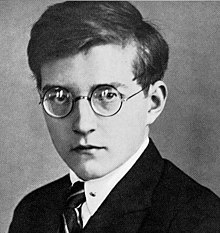The Nose (opera)
| The Nose | |
|---|---|
| Opera by Dmitri Shostakovich | |

The composer in 1925
|
|
| Description | satirical opera |
| Native title | Russian: Нос (Nos) |
| Librettist |
|
| Language | Russian |
| Based on |
The Nose by Nikolai Gogol |
| Premiere | 18 January 1930 Leningrad Maly Operny |
The Nose (Russian: Нос, 'Nos'), is Shostakovich's first opera, a satirical work completed in 1928 based on Nikolai Gogol's story of the same name (1836).
The opera was written between 1927 and 1928. The libretto is by Shostakovich, Yevgeny Zamyatin, Georgy Ionin, and Alexander Preis. Shostakovich stated it was a satire on the times of Alexander I. The plot concerns a St. Petersburg official whose nose leaves his face and develops a life of its own.
Gogol's original work was expanded by borrowing from some of his other works, including "The Overcoat", "Marriage", "Diary of a Madman", and "Dead Souls" as well as "The Brothers Karamazov" (1881) by Dostoevsky. The latter occurs in Act II, Scene 6 where Kovalev returns home to find Ivan singing. The song is Shostakovich's setting of the words of Part 2, Book 5, Chapter 2 of Karamazov, where the lackey, Smerdiakov sings to his neighbour Mariia Kondratevna.
An invisible force ties to my beloved. Bless us, O Lord, her and me! Her and me! I'll give up a king's crown, if my beloved is happy. Bless us, O Lord, her and me! Her and me!
Shostakovich uses a montage of different styles, including folk music, popular song and atonality. The apparent chaos is given structure by formal musical devices such as canons and quartets, a device taken from Alban Berg's Wozzeck.
...
Wikipedia
